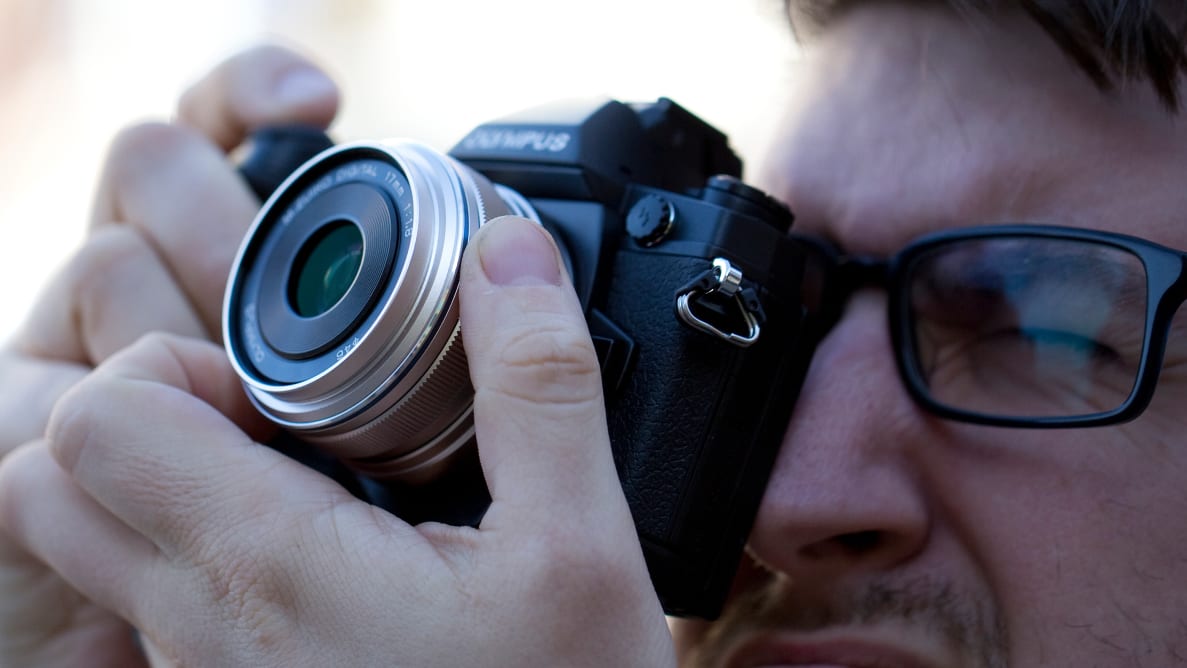Enter the premium-grade Olympus M.Zuiko 17mm f/1.8. If you’re an M43 shooter looking for a multi-purpose prime that happens to look and feel a lot like a manual focus lens from the film days, this is your ticket.
The 17mm focal length—when you consider that it's equivalent to a 34mm lens on a full-frame camera—gives the lens a flexible field of view that’s great for a lot of everyday shooting scenarios. This isn't the sharpest lens in Olympus's lineup, but if you’re looking for a standard prime with high-quality build for a Micro Four Thirds camera, the 17mm is a solid candidate.
Who's It For?
If you're just branching out from your kit zoom, the Olympus 17mm f/1.8 is a good pick—especially if you prefer a slightly wider than "normal" field of view. Its sub-$500 price makes it accessible even to beginners, though it does face some stiff competition from the cheaper and extremely sharp Panasonic 20mm f/1.7.
What the 17mm f/1.8 offers over the Panasonic 20mm is rock-solid all-metal build quality and a classic retro look. When it's paired with an Olympus PEN or OM-D camera, you’d be forgiven for confusing the setup for an old-school film rig. Aside from the build, it also offers Olympus's trademark focus clutch, which lets you slide the focusing ring forward for autofocus and back for manual focus, with stiffer resistance for more accurate results.
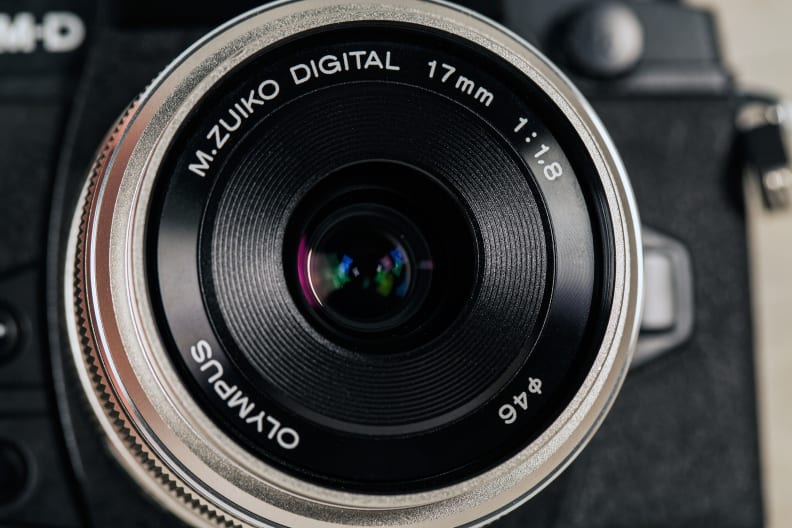
Despite the small front element, this lens boasts an impressive f/1.8 max aperture that lets in plenty of light.
This lens is also quite fast, with an f/1.8 aperture that accommodates low-light shooting well and gives you great separation between your subject and the background when you focus up close. It may not be the sharpest lens in the Micro Four Thirds system, but it occupies a unique spot for the moment—for many, that will be enough.
Look and Feel
The M.Zuiko 17mm f/1.8 is a jewel-like lens with top-notch build quality, and it's available in both silver and black to match your Olympus camera. (Though, frustratingly, the silver paint Olympus uses on its high-end primes has a more champagne hue than its bluish bodies.)
This lens has one of the most fine-tuned manual focus rings in Olympus’s whole lineup, thanks to the clever focusing ring clutch. When you slide the ring back, it converts from autofocus to manual, tightens the focusing action, and reveals an engraved focusing scale. Only a few other Olympus lenses offer this feature—including the 75mm f/1.8 and 12-40mm f/2.8 PRO—and even fewer lenses in other systems can do the same thing.
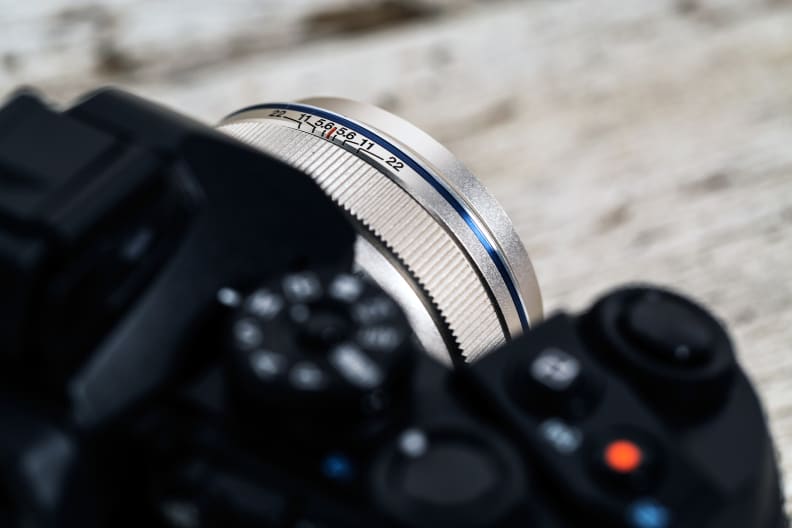
The focus ring slides back and forth to reveal two different modes: autofocus and manual focus, the latter with increased resistance and an engraved focus scale.
The body and rings are made of premium metal, with engraved lettering all around. The lens's small front element belies the fact that it has a fast f/1.8 aperture. Around the the front edge of the lens is a subtle blue ring, along with a bit of chrome trim that signifies this lens’s premium status in the Olympus lineup. The MSC badge indicates it includes a super-quiet autofocus motor—an invaluable feature when shooting video.
The only disappointment? The 17mm f/1.8 is a little more expensive than similar lenses in the Micro Four Thirds system. You’d think that at the $500 asking price it might come with some modest extras in the box, like a case or a lens hood, right? Wrong. While there is a compatible lens hood available, it’ll cost you an extra $60. There’s also a premium metal lens cap that's designed to slip over the lens hood. That’s an extra $30, depending on where you shop.
{{ photo_gallery name="tour" }}
Image Quality
Given our past experience with premium Olympus lenses, we had high hopes for this 17mm f/1.8. But while it's undoubtedly a major upgrade over both the older Olympus 17mm f/2.8 your average kit lens, it has enough issues to keep us from giving it our wholehearted recommendation.
Sharpness isn't a problem in the center—even when you open the aperture all the way up at f/1.8, resolution is high. This lens produces its sharpest results once you stop it down to f/4, with center sharpness that's over 2,000 lines. But unfortunately, the corners never improve the way we'd hope, staying below 1,300 lines at most apertures.

EXIF: 17mm, ISO 400, 1/60, f/1.8
The out-of-focus areas you can get from the 17mm f/1.8 are also pleasing, but there are some minor issues to keep in mind. There's some obvious coma as you move toward the corners, and while we didn't notice much fringing, there's definitely some unwanted texture to the highlights as the "onion ring" effect rears its ugly head.
While a little ovoid, the shape of the bokeh is at least soft and roundish without strong haloing. The 17mm f/1.8's seven rounded aperture blades also work to keep the bokeh more consistent as you stop down, unlike some lenses that can create geometric-looking out-of-focus elements.
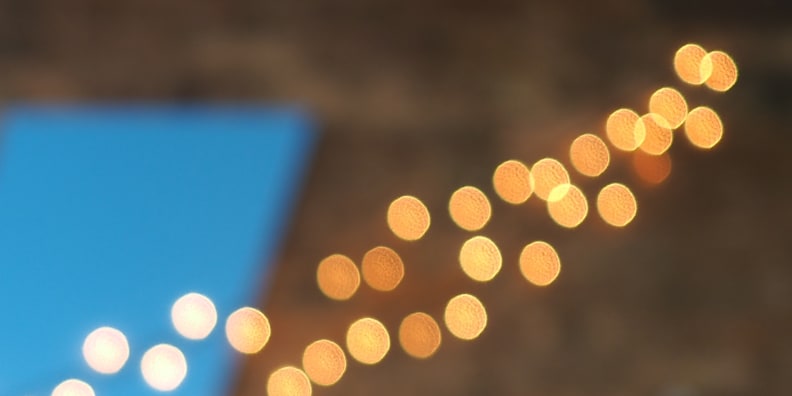
The bokeh produced by the M.Zuiko 17mm f/1.8 is not quite perfectly round and halos are evident.
These issues were evident in real-world shooting. The lens can create nice subject separation if you're focusing closely and using the maximum aperture, but the results aren't as sharp as what you get when you stop down. Shooting wide open gives you some lovely bokeh, but it's plagued by onion ringing that's so bad that you have to be very careful when sharpening your photos—something you'll definitely want to do, given the iffy f/1.8 results.
Ultimately, you can still take some very lovely photos with this lens, but there are compromises to keep in mind.
Below you can see sample photos taken with the Olympus M.Zuiko 17mm f/1.8 mounted on an Olympus OM-D E-M1. Click the link below each photo to download the full-resolution image.
{{ photo_gallery name="sample" }}
Conclusion
While we found that this lens is a capable performer under the right circumstances, and we love its signature “snapshot” focus ring, there are simply better choices out there for Micro Four Thirds shooters—several of which are actually less expensive.
We love the Olympus 25mm f/1.8, for instance. While it’s not made of metal, it's lightweight and super sharp, with a very useful 50mm equivalent focal length. If you’re after a pancake lens, the Panasonic Lumix 20mm f/1.7 is an excellent alternative that bridges the gap between the 17mm and 25mm focal lengths. If you have a smaller camera like the PEN E-P5 or Lumix GM1, the 20mm f/1.7 can round out a pocket-friendly setup.
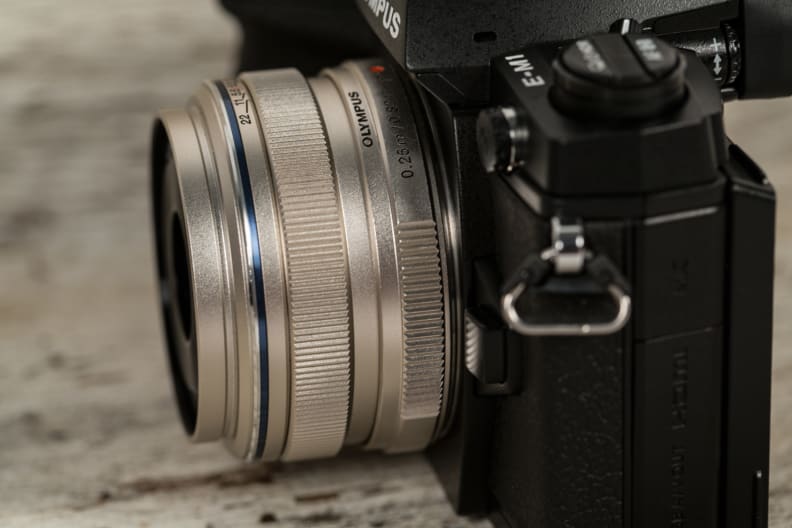
The 17mm f/1.8 is compact enough for travel and sharp enough for most purposes, but it's on the expensive side compared to similar lenses.
That said, this lens is very well built. It’s $100 more than the Olympus 25mm f/1.8 and it feels way more premium in your hands. The focus ring is excellent, and it complements the retro good looks of cameras like the Olympus PEN, OM-D, or Panasonic Lumix GX7 quite well. If you loved your 35mm prime in the film days, be prepared to fall in love all over again with the Olympus M. Zuiko 17mm f/1.8.
From a pure performance standpoint, however, the 17mm f/1.8 comes up a bit short of the M43 pack. That's no sin—it has become a deep, well-rounded system in the last couple years—but it's enough to give us pause. For the right shooter, this lens is definitely worth the money, but others may be better served by one of its many rivals. When evaluating any lens, we focus on four key areas: sharpness, distortion, chromatic aberration, and bokeh. A perfect lens would render the finest details accurately, wouldn’t distort straight lines or produce ugly fringing around high-contrast subjects, and would create smooth out-of-focus areas.
The Olympus 17mm f/1.8 was designed early on for the Micro Four Thirds mount, back when the image sensors primarily topped out at 12-megapixel. It does well on those cameras, but on newer 16-megapixel Micro Four thirds bodies—and especially compared to newer lenses—it is held back by mediocre sharpness.
In the other key areas, however, it excels, to say nothing of its combination of price, performance, size, and creative capabilities. Ultimately our lab tests didn't reveal it to be the best lens in the Micro Four Thirds family, but as an affordable starting point, you can do worse.
Sharpness
A lens's sharpness is its ability to render the finest details in photographs. In testing a lens, we consider sharpness across the entire frame, from the center of your images out to the extreme corners, using an average that gives extra weight to center performance. We quantify sharpness using line widths per picture height (LW/PH) at a contrast of MTF50.
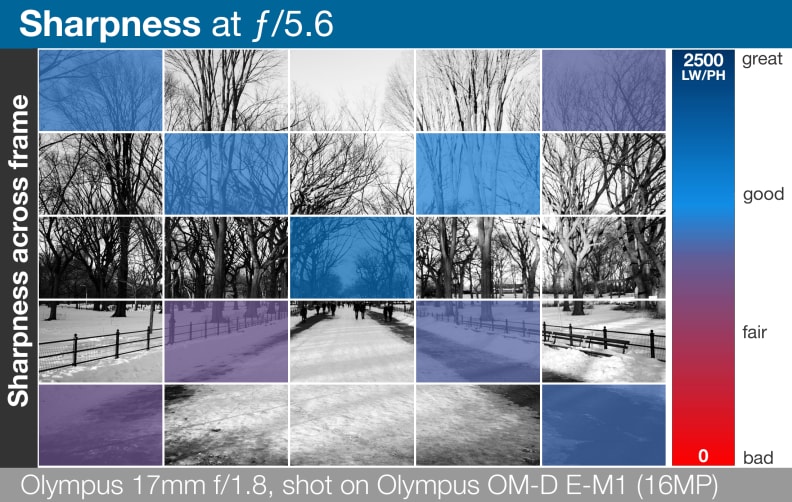
Stopping down to f/5.6 makes pesky softness issues go away.
Like many fast prime lenses, the Olympus 17mm f/1.8 starts off with a respectable performance in the center and soft corners at its maximum aperture. In our lab tests with the camera mounted on the OM-D E-M1 we recorded resolutions as high as 1,450 lines in the center and just shy of 1,000 lines in the corner.
Unlike many fast primes, however, when you stop down the corners and midway regions just don't improve to the same degree that we're used to seeing. The center gets much better—hovering around 1,950 lines from f/2.8 right to f/5.6 before hitting the diffraction limit—but the corners never get above 1,300 lines.
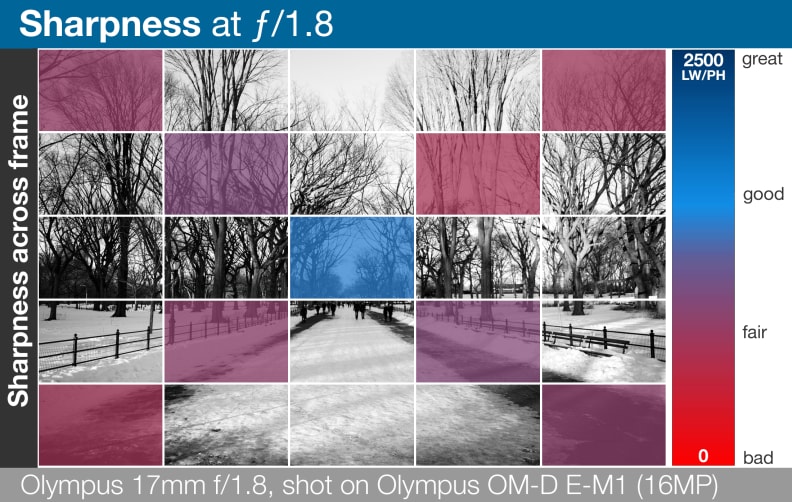
Outside of the center, shots at full wide suffer softness issues.
Ultimately, that's not a terrible result, but it's a notable step down from many of the other, superb primes you can get for Micro Four Thirds bodies. You can definitely get sharp photos out of this lens, but it just slightly lags behind the competition at most settings.
Distortion
We penalize lenses for distortion when they bend or warp images, causing normally straight lines to curve.
There are two primary types of distortion: When the center of the frame seems to bulge outward toward you, that’s barrel distortion. It's typically a result of the challenges inherent in designing wide-angle lenses. When the center of the image looks like it's being sucked in, that’s pincushion distortion. Pincushion is more common in telephoto lenses. A third, less common variety (mustache distortion) produces wavy lines.
We recorded almost no visible distortion with the Olympus 17mm f/1.8. At its worst we recorded just 0.3% barrel distortion, which is very minimal. Even in the shots that you can see it, you can easily correct it in post with minimal effort and no loss of quality.
Chromatic Aberration
Chromatic aberration refers to the various types of “fringing” that can appear around high contrast subjects in photos—like leaves set against a bright sky. The fringing is usually either green, blue, or magenta and while it’s relatively easy to remove the offensive color with software, it can also degrade image sharpness.
The 17mm f/1.8 just toes the line between "insignificant" and "minor" CA in our lab tests. It is visible if you push the lens and really go pixel peeping, but it's almost negligible in real-world photos and at anything close to reasonable viewing distances.
Bokeh
Bokeh refers to the quality of the out of focus areas in a photo. It's important for a lens to render your subject with sharp details, but it's just as important that the background not distract from the focus of your shot.

The bokeh produced by the M.Zuiko 17mm f/1.8 is not quite perfectly round and halos are evident.
While some lenses have bokeh that's prized for its unique characteristics, most simply aim to produce extremely smooth backgrounds. In particular, photographers prize lenses that can produce bokeh with circular highlights that are free of aspherical distortion (or “coma”).
Bokeh for the 17mm f/1.8 is not poor by any stretch, but it fails to reach the same heights as some of its other peers in the Micro Four Thirds lens family. A big reason for this is the relatively wide focal length, which doesn't isolate subjects as well as longer lenses like the 45mm f/1.8. It's also got some serious onion ringing issues, as you can see in the sample above.

EXIF: 17mm, ISO 400, 1/60, f/1.8
Still, in certain scenes the 17mm f/1.8 will produce nice, smooth backgrounds. There's a hint of business, and a bit of swirling due to the coma near the edges, but the shots have a certain character that is pleasing at times. The main issue is just that texture, as it only gets worse if you apply a sharpening mask to your shots, something you will likely want to do given the soft corner performance at many apertures.
Meet the tester
Brendan is originally from California. Prior to writing for Reviewed.com, he graduated from UC Santa Cruz and did IT support and wrote for a technology blog in the mythical Silicon Valley. Brendan enjoys history, Marx Brothers films, Vietnamese food, cars, and laughing loudly.
Checking our work.
Our team is here for one purpose: to help you buy the best stuff and love what you own. Our writers, editors, and lab technicians obsess over the products we cover to make sure you're confident and satisfied. Have a different opinion about something we recommend? Email us and we'll compare notes.
Shoot us an email
